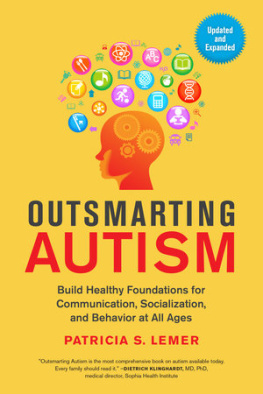ROUTLEDGE LIBRARY EDITIONS: COMMUNICATION STUDIES
Volume 1
COMMUNICATION AND SEX-ROLE SOCIALIZATION
COMMUNICATION AND SEX-ROLE SOCIALIZATION
Edited by
CYNTHIA BERRYMAN-FINK,
DEBORAH BALLARD-REISCH, AND
LISA H. NEWMAN
First published in 1993 by Garland Publishing, Inc.
This edition first published in 2016
by Routledge
2 Park Square, Milton Park, Abingdon, Oxon OX14 4RN
and by Routledge
711 Third Avenue, New York, NY 10017
Routledge is an imprint of the Taylor & Francis Group, an informa business
1993 Cynthia Berryman-Fink, Deborah Ballard-Reisch, and Lisa H. Newman
All rights reserved. No part of this book may be reprinted or reproduced or utilised in any form or by any electronic, mechanical, or other means, now known or hereafter invented, including photocopying and recording, or in any information storage or retrieval system, without permission in writing from the publishers.
Trademark notice: Product or corporate names may be trademarks or registered trademarks, and are used only for identification and explanation without intent to infringe.
British Library Cataloguing in Publication Data
A catalogue record for this book is available from the British Library
ISBN: 978-1-138-93903-5 (Set)
ISBN: 978-1-315-67052-2 (Set) (ebk)
ISBN: 978-1-138-94150-2 (Volume 1) (hbk)
ISBN: 978-1-315-67051-5 (Volume 1) (ebk)
Publishers Note
The publisher has gone to great lengths to ensure the quality of this reprint but points out that some imperfections in the original copies may be apparent.
Disclaimer
The publisher has made every effort to trace copyright holders and would welcome correspondence from those they have been unable to trace.
COMMUNICATION AND SEX-ROLE SOCIALIZATION
edited by
Cynthia Berryman-Fink,
Deborah Ballard-Reisch,
and
Lisa H. Newman
1993 Cynthia Berryman-Fink, Deborah Ballard-Reisch,
and Lisa H. Newman
All rights reserved
Library of Congress Cataloging-in-Publication Data
Communication and sex-role socialization / edited by Cynthia Berryman-Fink, Deborah Ballard-Reisch, and Lisa H. Newman.
p. cm. (Garland reference library of social science; vol. 889)
Includes bibliographical references (p. ) and index.
ISBN 0815312563
1. Sex roleUnited States. 2. SocializationUnited States. 3. WomenUnited StatesSocialization. 4. CommunicationSex differences. I. Berryman-Fink, Cynthia, 1952 II. Ballard-Reisch, Deborah. III. Newman, Lisa H. IV. Series: Garland reference library of social science ; v. 889.
HQ1075.5.U6C64 1993
305.3dc20
92-33993
CIP
Printed on acid-free, 250-year-life paper
Manufactured in the United States of America
To our sons, Andrew, Gregory, Stefan, and Rhys, with hope that your futures will include a society that values diversity, respects androgyny, and applauds flexibility.
CONTENTS
Pamela Cooper
David C. Lundgren and Amy Cassedy
Judi Beinstein Miller, Elizabeth Ashby Plant, and Elizabeth Hanke
Beth J. Haslett
Judi Beinstein Miller and Mary Lane
Daniel J. Weigel and Randy R. Weigel
Lisa Merrill
David W. Schlueter and J. Kevin Barge
Sue DeWine, Judy C. Pearson, and Christine Yost
Alice H. Deakins
Marjorie Keeshan Nadler and Lawrence B. Nadler
John Parrish Sprowl
Dayle C. Hardy-Short
Judith S. Trent and Teresa Chandler Sabourin
Janice E. Schuetz
Deborah S. Ballard-Reisch and David R. Seibert
Elizabeth E. Graham and Michael J. Papa
B. Christine Shea
Phyllis R. Randall and Mary Elizabeth Jarrard
Melanie Booth-Butterfield
Linda A.M. Perry
J.C. Condravy
Helen M. Sterk and Karen J. Sterk
Constance Courtney Staley
Richard West and Roberta A. Davilla
Lynn H. Turner
Victoria Leto DeFrancisco
Patricia M. Buzzanell
Judy C. Pearson
Socialization can be defined as the comprehensive and consistent induction of an individual into the objective world of a society or a sector of it (Berger and Luckmann, 1966, p. 130). Through both systematic and random experiences, individuals learn to behave in ways that encourage predictability and the continuity of group life. Socialization is not a simple sculpting of human personality and behavior, however. As Wentworth (1980) indicates, socialization is not a mere mechanistic passing-on or transfer of discrete packages of information between the social system and the individual. The individual plays a role in the accepting, internalizing, and limiting of ideas provided by external socializing agents. There is a continuous interplay between external forces and ones cognitive organizing of experiencesa type of dialectical tension between the individual and society which comprises the socialization process.
Therefore, as Staton (1990) argues, socialization is not a static process but rather one that occurs continually throughout life, and individuals are often socialized into different segments of society simultaneously. Berger and Luckmann (1966) distinguish between two types of socialization: primary and secondary socialization. Primary socialization is the first socialization an individual undergoes in childhood through which s/he becomes a member of society (). They further argue that there are cognitive, affective, and normative components of socialization.
One of the most fundamental and pervasive aspects of socialization is the teaching and learning of sex-role behavior. Bate and Taylor (1988) make a good point when they say that biological sex and the psychological and sociocultural features called gender easily become confounded when scholars employ sex and gender as undefined, overlapping terms (p. 2). We agree that it may be clearer and conceptually more valid to use the term sex to denote biological features that distinguish men from women, and to use the term gender to refer to the learned and socially evaluated behaviors and attitudes people associate with the words: men and women, girls and boys, and feminine and masculine. Yet, sex continues to be the most used and recognizable term in the literature and will be used throughout this manuscript.
While much socialization occurs in childhood, sex-role socialization continues over the entire life span. The sex-role socialization that an individual receives in childhood cannot be a fully adequate preparation for an entire lifetime. Through secondary socialization we continue to learn what is deemed appropriate for men and women at certain stages of life, in various adult contexts, and in relation to societal events and changes. That is not a linear process, as there may be conflicts rather than a continuity between earlier socialization in childhood and later socialization as an adult.
The literature on sex-role socialization has burgeoned during the last twenty years. Sex-role socialization has been analyzed from many angles and within many academic disciplines, including sociology, psychology, anthropology, womens studies, and communication. The two main perspectives represented in this book are the sociological and communication perspectives. The sociological viewpoint is marked by its concern for the aggregate rather than the individualdescribing what is characteristic in the way of behavior and thought for members of a society or for a specific social category within that society (Wilson & Boudreau, 1986). The communication perspective examines the dynamics of everyday human interaction and interprets findings by using language and relational conventions that are drawn from the general human communities they are attempting to understand or explain (Carter & Spitzack, 1989).







